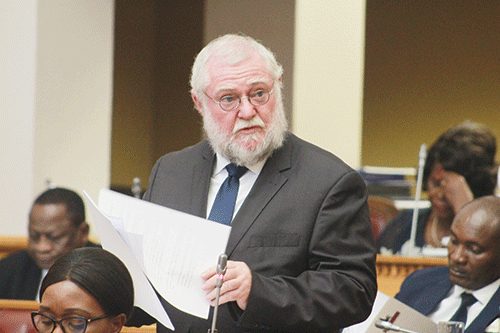Lahja Nashuuta
Land reform minister Calle Schlettwein has admitted that Namibia’s ambitious land reform policy failed to reach its intended outcomes, despite recording some successes.
“We acknowledge that the land reform programme, particularly the resettlement process, has been slow and ineffective.” He made this ststement while tabling the new National Resettlement Policy 2023/2033 in the National Assembly for input last week.
The new resettlement policy will replace the one which has been in place for the past decade.
According to the minister, the archaic policy has not allowed the government to effectively address the land question, particularly around who should benefit from the resettlement process.
The former finance minister cited the mismatch between the policy and the criteria for the allocation of acquired land as loopholes in the existing policy.
Due to this shortcoming, most of the acquired land has been allocated to individuals with no capacity to productively use it.
White elephants
In the absence of monitoring and evaluation data, Schlettwein opined that agricultural production on most of the resettlement farms has declined compared to when such farms were under private ownership.
He attributed this to lack of skills, training and insecure land tenure rights, lack of marketing, poor farm infrastructure, water scarcity, limited credit, small land size, animal diseases and theft.
Well-connected
The minister seemingly gave credence to the perception that the land allocation modalities favour already privileged or well-off individuals.
He further acknowledged the absence of the pre and post settlement support, which includes adequate structured and coordinated support to resettlement beneficiaries, is one of the main reasons for the poor agricultural productivity in most of the resettlement farms.
“Most resettlement farms seem to lack management capacity and basic agricultural skills, hence their perpetual reliance on random government support,” Schlettwein said.
Target
According to the national resettlement policy [2023-2033], under the national resettlement process, the government has targeted the acquisition and distribution of five million hectares of commercial agricultural land by 2030.
So far, only 513 commercial farms totalling 3.1 million hectares of land have been acquired and allocated to over 5 300 beneficiaries since independence.
While figures of landless Namibians in need of resettlement are unavailable, the policy estimates that a total of 243 000 Namibians need land.
At the heart of Namibia’s land reform policies is addressing remnants of past injustices such as apartheid and colonialism, which denied indigenous Namibians ownership of land.
The national resettlement programme, which the government adopted in the 1990s, allows the government to buy freehold land to resettle landless Namibians.
It has followed the controversial “willing buyer, willing seller” principle.
Added to this is the Affirmative Action Loan Scheme, which allows formerly disadvantaged people to get subsidised loans through Agribank to buy land.
New dawn
After persistently failing to come close to its land reform targets, the government now hopes to reach it by 2033 through the 2023/2033 land resettlement policy.
The government promises to change the status quo by ensuring that the right people benefited from the resettlement programme.
According to the new resettlement plan, only Namibians citizens who do not own and who socially, economically and educationally discriminated by previously discriminatory laws or practices are entitled to benefit.
It also seeks to address the existing skewed land ownership by placing formerly disadvantaged Namibians into the mainstream of the national economy.
The new resettlement plan has categorised resettlement into three models tailored to the vying land needs of the eligible beneficiaries. One of them is the higher economic model which targets the empowerment of mainly landless commercial farmers farming on least commercially viable agricultural land, which is privately-owned or belongs to local authorities.
More so, under the proposed policy, only commercially-oriented communal farmers with well-established farming ventures in communal areas but cannot secure agricultural loans from banks, as affirmative action candidates, fall under this category.
Meanwhile, the small to medium holders communal farmers in overcrowded areas whose farm ventures are threatened by the environment in which they operate will now be listed under moderate economic value model, which targets people who have demonstrated through their ongoing farming ventures in communal areas that they can farm commercially if provided with opportunity to do so.
The envisaged model provides an effective way to decongest overcrowded commercial areas.
While the low economic value model is targeting landless citizens who are neither farming in communal areas or leasing on private owned commercial farmland, it also includes those without access to capital, low-income earners and those without income but want to venture into small scale farming.
“This policy will require a regular review of the current resettlement selection criteria in order to ensure that it is tailored according to the specific model of resettlement suggested herein and that the land acquired and made available for allotment should be targeted toward beneficiaries falling within those categories,” said the minister.
Context
The most recent available statistics indicated that over 70% of Namibia’s productive land is still in the hands of previously advantaged Namibians (whites).
As such, the land question remains a hot potato in many respects.
Back in 2018, the late president Hage Geingob convened the second national land conference, which resulted in 169 resolutions.
According to the latest available information, only a paltry 25 of the 169 resolutions taken at that indaba have been fully implemented, a draft progress report on the second national land conference reveals.
Furthermore, the draft Land Bill, which encapsulates most of the resolution adopted during the 2018 indaba, is expected to be tabled in the National Assembly later this year.
Among the five thematic areas from the 2018 conference was the issue of ancestral land claims and restitution, which resulted in the establishment of a commission on ancestral land. This commission submitted its findings to Geingob a few years ago.
-lnashuuta@gmail.com


